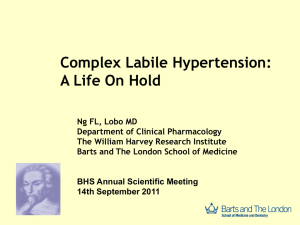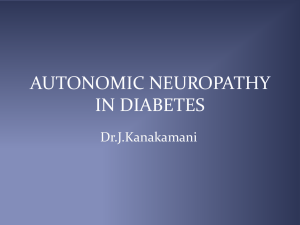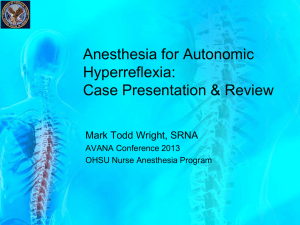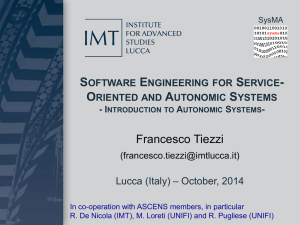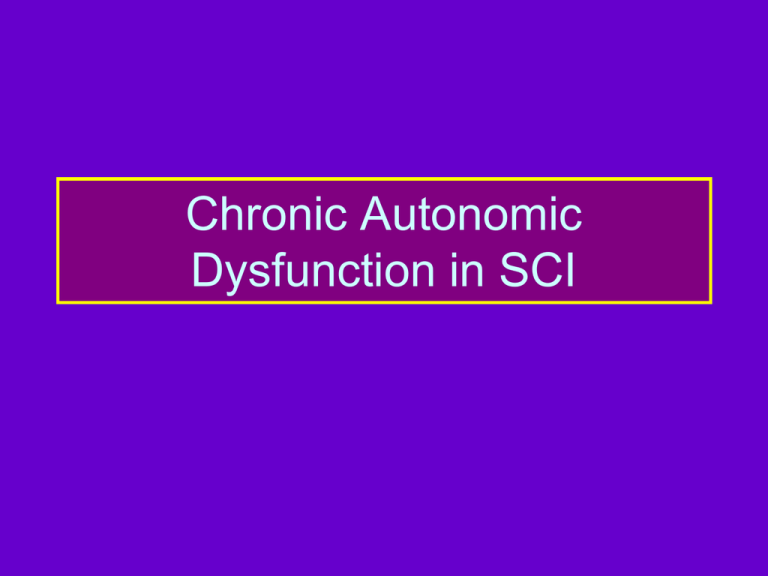
Chronic Autonomic
Dysfunction in SCI
Aims of this Session
• Describe autonomic dysfunction: physiology,
pathophysiology in SCI
• Discuss lasting effects of autonomic dysfunction
in SCI
• Describe severe autonomic dysreflexia, its
recognition, treatment and prevention
Autonomic Dysfunction:
Physiology & Pathophysiology of SCI
• SCI affects the somatic (i.e. the sensory and
motor pathways we are aware of and can
control) nervous system below the level of the
injury
• However the autonomic (i.e. ‘self-regulating’)
nervous system is also affected, and, like the
somatic central nervous system, the severity and
extent of the damage is largely related to the
level and neurological completeness of the injury
What is the Autonomic Nervous System?
• The ANS maintains many body systems that
need to run constantly without conscious effort:
for example breathing, digestion, secretion and
storage of urine, thermoregulation, circulation of
blood.
• The ANS can be viewed as two systems, the
sympathetic and parasympathetic, which
respond to each other and the external
environment in order to maintain an internal
equilibrium while facilitating conscious response
to challenges (‘flight or fight’)
Parasympathetic
Sympathetic
What is the Autonomic Nervous System?
• It is important to realise that the primary mode of
action of the autonomic nervous system is the
reflex: stimulus-response.
Autonomic Dysfunction:
Physiology & Pathophysiology of SCI
• As we have seen the parasympathetic and
sympathetic tend to involve distinct levels of the
spinal cord
• This means that the nature of the autonomic
dysfunction in an individual is heavily influenced
by the location and extent of the SCI
Autonomic Dysfunction Landmarks
brain
UMN lesion
Spasm
Reflex NBD
Reflex erection
LMN lesion
No spasm
Areflexic NBD
Severe erectile
dysfunction
sympathetic cardioaccelerator
supply T6
Profound spinal shock
Risk of severe autonomic
dysreflexia
C1-C7
T1-T6
T7-T12
L1-L5
S1-S5
coccyx
Neurological Completeness of Injury:
Risk of Severe Autonomic Episodes
100%
90%
80%
70%
60%
50%
40%
30%
20%
10%
0%
119
24
A
28
5
B
48
6
C
ASIA score
201
32
3
0
D
E
No AD
AD
High Risk Group: AIS ‘A’ Tetraplegics
Chronic Autonomic Dysfunction in SCI
• After spinal shock has subsided, there will be a
persistent autonomic dyssynergy, again relative
to level and density of lesion
• The parasympathetic and sympathetic systems
will not be properly moderated or inhibited by
each other, which will often result in
hyperreflexia, particularly of the sympathetic
system
• This will often have evident functional
physiological consequences
Cardiovascular System
Signs
Mechanism
Hypotension
(postural)
Passive dilatation of
blood vessels below
injury
(sympathetic inactivity)
Bradycardia
Unopposed vagal
stimulation
(sympathetic inactivity)
Poikilothermia
Passive dilatation of
blood vessels below
injury
(sympathetic inactivity)
Effect
Syncope (dizziness, fainting,
visual disturbance) when
sitting up suddenly
The BP is often very labile
Tetraplegics may often have a
labile HR with a low resting
pulse. This can lead to
misdiagnosis
Potential hypothermia
Respiratory system
Mechanism
Effect
respiration, Diaphragmatic respiration
PO2
Nasal
blockage,
stuffiness
Vasodilation of face and air passages
Inability to
expectorate
effectively
Absent intercostals and auxiliary
respiratory muscles
(compensatory sympathetic overactivity)
Often becomes
interpreted that
bladder or bowels
are about to
empty
Chest infection
Gastrointestinal System
Signs
Mechanism
Nausea, vomiting,
bloating
Slow gastrocolonic transit
Constipation, faecal
incontinence
Neurogenic bowel dysfunctions
‘Silent’ autonomic dysreflexia
(sympathetic inactivity)
(sympathetic/parasympathetic
dyssenergy with no somatic
influence)
Skin
Signs
Mechanism
(sympathetic
Marks easily
Sweating, gooseflesh, hyperreflexia)
flushing (often in
response to
sympathetic stimulation
rather than heat or
cold)
Poikilothermia
(sympathetic
dyssynergy)
Effect
Increased risk of pressure
ulcers, discomfort
Danger of causing burns to
anaesthetic skin when
attempting to correct
hypothermia
Genitourinary System
Signs
Mechanism
Effect
Intermittent
oligouria
Poor renal perfusion when
sitting due to postural
hypotension
(sympathetic inactivity)
Reduced urine output when
mobilising, with compensatory
polyuria overnight
Dependent oedema of lower
limbs
Retention of
urine
Bladder reflexes
absent/ineffective
Blocked urinary catheter
(sympathetic and
parasympathetic dyssynergy)
Damage to upper urinary tract,
infection and haematuria
Autonomic dysreflexia
Erectile and
ejaculatory
dysfunction
Disruption of reflex pathways
Treatment required for erectile
and ejaculatory dysfunctions
Amenorrhea
Secondary to nutritional and
metabolic deficits
Tends to resolve within 6/12,
with resultant normal fertility
Chronic Autonomic Dysfunction in SCI
• Autonomic symptoms can be many and various
• Many of these can be distressing
• In the absence of normal somatic sensation
these can be a useful aid to diagnosis
• Many SCI individuals ‘learn’ to interpret
autonomic signs usefully
Chronic Autonomic Dysfunction in SCI
• Distressing autonomic symptoms can often be
addressed rationally. For example:
– Sweating often responds to
sympatheticomimetics (oxybutynin etc)
– Postural hypotension is treated by gradual
mobilisation, and use of elastic stockings and
abdominal binder. Sometimes ephedrine is
used
• However attention must be given to any
underlying cause- particularly bladder and bowel
management
What is Autonomic Dysreflexia?
• Severe autonomic dysflexia is a sudden rise in
blood pressure in response to a harmful stimulus
(usually the increase in pressure in a body cavity
caused by the collection of fluid)
• Untreated, this rise in blood pressure may
continue and result in cerebrovascular events or
even death
What is Autonomic Dysreflexia?
• The noxious stimulus triggers unmediated
sympathetic reflex activity which causes massive
vasoconstriction below the level of injury.
• This in turn causes a rise in central blood
pressure which causes an alarming headache
• The area above the lesion tries to compensate
with vasodilation, causing flushing and sweating
What is Autonomic Dysreflexia?
• In most cases the noxious stimulus is
urine in the bladder (probably above 90%
of new dysreflexia)
• In practice (outside of SCI Centres) this is
usually due to a blocked catheter
What is Autonomic Dysreflexia?
• Bowel triggers are constipation, anal
fissure, bleeding haemorrhoids etc
• Other (rarer) primary causes include
infected pressure sores and abscesses,
pus from an ingrowing toenail collecting
behind the nail, and DVT
Recognition of Severe
Autonomic Dysreflexia
• Non- drainage of urine
• Severe headache
• (raised BP)
• (sweating and flushed above lesion)
Treatment of Severe
Autonomic Dysreflexia
• Change catheter (do not attempt washout)
• (Give chemical vasodilator eg: GTN)
• Reassure
• (Elevate head)
Prevention of severe
Autonomic Dysreflexia
• Good bladder and bowel management:
– Regular catheter change
– Avoid constipation



